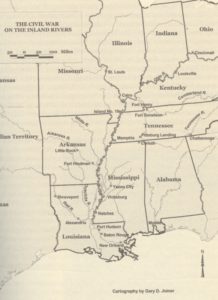Early 1862 Military Moves In the West: Part 2
Once he approved the joint naval and land operation against two Tennessee River fortifications, Fort Henry and Fort Donelson twelve miles away, General Halleck gave the project his full support. He even transferred 5,000 soldiers to Grant from General Buell’s army.
The stakes were high. At stake for the Confederates was their entire position in the state of Kentucky, control of Nashville, Tennessee and the fort which dominated the Mississippi River at Columbus, Kentucky. Also, at risk was the Confederate control of the Memphis & Charleston railroad in western Tennessee.

In preparation for the attacks, Grant had difficulty finding adequate river transportation for his approximate 15,000 man force. Divided into two divisions, he could only move one at a time into position for his move against Fort Henry. That problem and bad roads & streams swollen by spring floods slowed him down, too. So, naval Captain Andrew Foote, began the attack against fort Henry without infantry support on the 6th of February, 1862.
Foote’s ironclads led the attack firing directly into Fort Henry. The Timberland boats under his command followed in line to lob mortar shells into the fort, as well. In short order, the fort’s building and tents were ablaze and only four of it’s eleven guns remained in operation. But, the Confederates gave as good as they got, damaging several of the Federal boats.
Never-the-less, anticipating the expected arrival of Grant’s force of 15,000 men, the Confederate Commander, General Tilghman, ordered the white flag of surrender raised. Then, he directed his troops to leave for Fort Donelson twelve miles away.
Several of Foote’s boats were damaged in the fight and would not be available for the attack on Fort Donelson. The capture of Fort Henry had been a naval victory. But the subsequent assault on Fort Donelson would be up to the Federal infantry.


 A Great Read! I couldn’t put this book down once I got started. The detail was great and I really like the main character, Michael. Knowing that so much research went into this book made it exciting to read!
A Great Read! I couldn’t put this book down once I got started. The detail was great and I really like the main character, Michael. Knowing that so much research went into this book made it exciting to read!